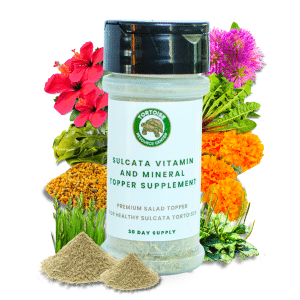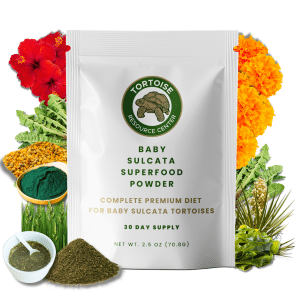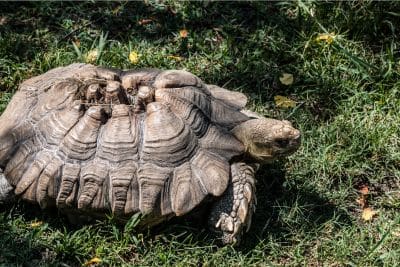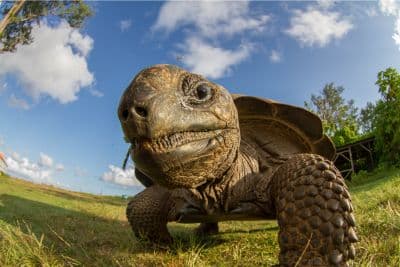As ectothermic (“cold-blooded”) animals, tortoises differ significantly from dogs, cats, and other endothermic (“warm-blooded”) animals.
For example, while mammals and birds heat their bodies from within, tortoises and most other reptiles must rely on external sources. And while mammals must generally eat every day, tortoises can sometimes go for very long periods of time without food.
The question is, exactly how long can a tortoise go without food?
Join me, as I dive into this topic and explain some of the reasons tortoises don’t have to eat as often as other creatures do.
Ectotherms vs Endotherms: Important Biological Differences
Most biological functions work best within a relatively narrow range of temperatures, though the precise range varies from one species to the next. But endothermic and ectothermic animals maintain their bodies within these temperature ranges in different ways.
Birds and mammals maintain their body temperatures by “burning” food rapidly enough that it releases heat. This heat warms the animal’s body and keeps it within the ideal range.
It’s worth noting that most endothermic animals are clad in insulating body coverings, which help retain much of the heat produced. For example, birds are covered in feathers, while most mammals are covered in a thick coat of fur. This is especially true of species living in areas with cold climates.
On the other hand, tortoises and most other reptiles cannot metabolize food quickly enough to generate much heat. Accordingly, they maintain suitable body temperatures by doing things like basking in the sun or moving to warmer micro-habitats.
The Benefits and Drawbacks of Both Approaches
Thus far, it sounds like warm-blooded animals have a distinct advantage over their cold-blooded counterparts. And in many ways, they do.
For example, endothermic animals can remain active when the temperature falls, while ectothermic animals become sluggish when the mercury plummets. They may even completely lose the ability to move if the temperatures fall far enough. Their immune systems also function more slowly in cold weather.
This means that a warm-blooded animal is better equipped to escape predators or capture prey in cold weather, and they’re also less likely to become sick.
But endothermy presents a very significant downside: Warm-blooded animals must consume a lot of food to keep their internal “furnace” burning. If they don’t consume enough food, they’ll quickly starve to death. Some birds and mammals with very fast metabolic rates or small body sizes may even starve to death in a few short days if deprived of food.
On the other hand, ectothermic animals don’t rely on their food to keep their internal “furnace” burning. This means they won’t starve nearly as quickly as warm-blooded animals. Indeed, some reptiles have been documented to have survived more than a year without food.
Lifestyle Adaptations
In addition to their slow metabolisms and ectothermic biology, tortoises exhibit some lifestyle adaptations that help them go long periods of time without food.
Most notably, tortoises remain inactive for several hours each day. Most tortoises emerge from their burrows or shelters early in the morning and begin searching for food or mates. A few hours later, they’ll typically return to a sheltered location, where they don’t expend much energy.
Some species and individuals will emerge again in the afternoon, but others are only active during the early portions of the day.
Additionally, tortoises will remain inactive for weeks or months at a time when the climate or weather is inhospitable.
This is most commonly associated with cold temperatures in the winter. Because tortoises can’t move very quickly and food may become scarce during the winter, species that live in temperate areas often brumate (the reptilian version of hibernating) until warm weather returns.
Some tortoises also do a similar thing during hot, dry summers, as excessively high temperatures can also be dangerous for them. So, they crawl down a hole and wait for cooler temperatures and rain to become active again. This is called aestivation.
How Long Can a Tortoise Go Without Food?
It isn’t clear exactly how long a tortoise can survive without eating. There are a couple of reasons this is the case:
- Tortoises are very difficult to study in the wild. Because of their often-secretive habits, researchers rarely have the chance to see a tortoise eat and then fast for a long period.
- Purposefully withholding food from a captive tortoise for a long period would be cruel. Keepers can and should withhold food from their pets at times (such as before hibernation), but these periods are generally measured in weeks.
- Tortoises may occasionally refuse food at times, but this is often a problem brought upon by a health issue. Accordingly, keepers are generally interested in enticing their tortoise to eat again as soon as possible.
It’s also important to note that different tortoise species and individuals are likely capable of surviving different lengths of time without food. Large tortoises can likely fast for longer periods than smaller tortoises can, and adults are unquestionably able to survive for longer without food than hatchlings are.
We know that most tortoises who hibernate end up fasting for 8 to 16 weeks, and occasionally longer. However, this takes place when the temperatures are low. It is likely that tortoises who’re currently exposed to warm temperatures require food more often than this.
Ultimately, it is likely that most healthy tortoises can survive for weeks without food during normal weather conditions, and some may be able to survive months without eating.
When to Worry if Your Tortoise Stops Eating
Tortoise keepers often become anxious when faced with a pet who won’t eat. This is understandably concerning, but it doesn’t always signal a serious problem.
Here are a few things you’ll want to consider when your tortoise stops eating:
- Is winter approaching? Tortoises often fast on their own accord when preparing to hibernate. In such cases, it is generally best to stop offering food and prepare to offer a hibernation period.
- Are the enclosure temperatures too cool? Low temperatures tend to suppress the appetite of tortoises, so you’ll want to check the enclosure temperatures. Be sure that the basking spot and overall enclosure are both warm enough.
- Have social factors changed in the enclosure? Sometimes, tortoises will start focusing on mating more than eating. At other times, tortoises may “bully” or dominate others in the enclosure, which can lead the smaller individual to stop eating.
- Did you switch the foods offered? Tortoises are all individuals, who exhibit slightly different tastes and dietary preferences. At times, keepers offer food that the tortoise simply does not like.
- Is the enclosure properly illuminated? Vision plays an important role in the recognition of food by tortoises. So, it is vital that you’re providing the right kind of full-spectrum lighting for your pets.
- Is your tortoise ill? This is the most troubling reason that tortoises refuse food. A variety of ailments may cause your tortoise to stop eating, but respiratory infections or high internal parasite loads are two of the most common. See your vet immediately if your tortoise stops eating and you note any signs of illness.
Also, keep in mind the duration of your tortoise’s fast. Fasts lasting a day or two are rarely cause for concern, but those that stretch on for weeks certainly can be problematic.
Generally speaking, you’ll want to see your vet immediately if your tortoise exhibits signs of illness while fasting such as difficulty passing feces, unhealthy looking poop, wheezing, mucus from the nose or mouth, and eye infections.
If your tortoise appears healthy, you probably don’t need to be seriously concerned unless a hatchling fasts for more than two or three days or an adult fasts for more than four or five days.
Factors Influencing a Tortoise’s Need for Food
It’s important to understand that a variety of factors can influence your tortoise’s need for food. Some things will cause your tortoise to need more food or to exhibit a stronger appetite, while other things will trigger the opposite response.
Some of the factors influencing your tortoise’s food requirements and appetite include:
- The type of food offered. Some vegetables and plant matter have relatively low caloric density, while others are bursting with calories. For example, grasses and weeds are typically full of fiber but contain relatively few calories. On the other hand, most fruits are high in sugar, and therefore calories.
- The enclosure temperatures. Generally speaking, tortoises kept at higher temperatures will exhibit stronger appetites than those maintained at lower temperatures. However, there are limits to this effect, as excessively high temperatures may trigger aestivation periods in some species, during which they’ll refuse food entirely.
- The amount of activity your tortoise enjoys. Tortoises that have large enclosures and get lots of exercise will often exhibit voracious appetites and consume more food. On the other hand, tortoises kept in small enclosures won’t enjoy as much exercise, which may decrease the amount of food they consume.
- Individual variation. All tortoises are individuals with varying appetites, metabolic rates, and food requirements. You may even see siblings consume significantly different quantities of food. This is generally not a problem, though tortoises with stronger appetites will often grow more quickly and reach larger sizes than those who aren’t as interested in food.
Keen to learn even more about tortoises? Why not click the link to this article about that’s all about tortoise anatomy.
Are You Starving Your Tortoise?
Save 10% on premium tortoise food and supplements from Tortoise Resource Center on Amazon now using code BUYNOWGET10

Sulcata Vitamin & Mineral Topper Supplement
30-Day Supply | 2 oz (56 g)
$24.99

Baby Sulcata Tortoise Superfood Powder
30-Day Supply | 2.5 oz (70.8 g) Bag
$24.99
Citations
- University of Illinois Urbana-Champaign – The Tortoise and Its Care
- Smithsonian’s National Zoo & Conservation Biology Institute – Aldabra Tortoise
- PangoVet – How Long Can a Tortoise Go Without Food?


